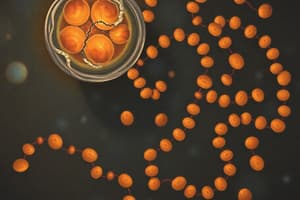Podcast
Questions and Answers
What is the last stage of cellular respiration where products from the Krebs cycle and glycolysis feed into?
What is the last stage of cellular respiration where products from the Krebs cycle and glycolysis feed into?
Electron transport chain
What is formed when high-energy electrons from glycolysis are passed to NAD+?
What is formed when high-energy electrons from glycolysis are passed to NAD+?
NADH
Where do NADH molecules join the NADH and FADH2 molecules generated by the Krebs cycle?
Where do NADH molecules join the NADH and FADH2 molecules generated by the Krebs cycle?
Mitochondrion
What does the electron transport chain use to synthesize ATP from ADP?
What does the electron transport chain use to synthesize ATP from ADP?
What is the final electron acceptor of the electron transport chain?
What is the final electron acceptor of the electron transport chain?
Explain the role of oxygen in the electron transport chain and why electron transport is considered aerobic.
Explain the role of oxygen in the electron transport chain and why electron transport is considered aerobic.
Describe how high-energy electrons from glycolysis and the Krebs cycle are utilized in the electron transport chain to synthesize ATP from ADP.
Describe how high-energy electrons from glycolysis and the Krebs cycle are utilized in the electron transport chain to synthesize ATP from ADP.
Explain the composition and location of the electron transport chain in eukaryotic cells.
Explain the composition and location of the electron transport chain in eukaryotic cells.
Explain the process of how high-energy electrons from glycolysis and the Krebs cycle are utilized in the electron transport chain to synthesize ATP from ADP.
Explain the process of how high-energy electrons from glycolysis and the Krebs cycle are utilized in the electron transport chain to synthesize ATP from ADP.
Describe how the electron transport chain in eukaryotes is composed and its location within the cell.
Describe how the electron transport chain in eukaryotes is composed and its location within the cell.
Explain the significance of oxygen as the final electron acceptor in the electron transport chain and the consequences of its absence.
Explain the significance of oxygen as the final electron acceptor in the electron transport chain and the consequences of its absence.
Flashcards are hidden until you start studying




